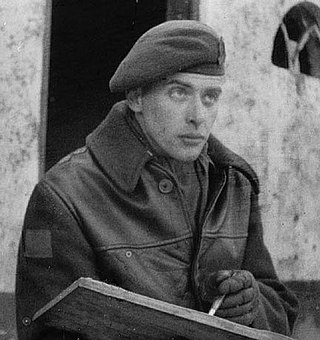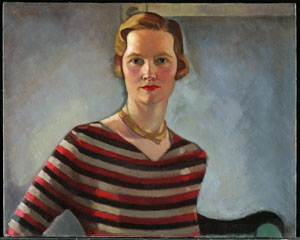Related Research Articles

Mary Frances Pratt, D.Litt was a Canadian painter known for photo-realist still life paintings. Pratt never thought of her work as being focused on one subject matter: her early work is often of domestic scenes, while later work may have a darker undertone, with people as the central subject matter. She painted what appealed to her, being emotionally connected to her subject. Pratt often spoke of conveying the sensuality of light in her paintings, and of the "erotic charge" her chosen subjects possessed.

Joint Task Force 2 is Canada's Tier 1 special operations force mandated with protecting Canadian national interests and combating terrorism threats both domestic and abroad. JTF 2 serves under the Canadian Special Operations Forces Command of the Canadian Armed Forces and is typically compared to American Delta Force and SEAL Team Six, the British Special Air Service, the Australian Special Air Service Regiment and 2nd Commando Regiment, and the New Zealand Special Air Service. Most information concerning JTF 2 is classified and is not usually commented on by the Canadian Armed Forces or the Government of Canada.

Kenneth Roy Thomson, 2nd Baron Thomson of Fleet, known in Canada as Ken Thomson, was a Canadian/British businessman and art collector. At the time of his death, he was listed by Forbes as the richest person in Canada and the ninth richest person in the world, with a net worth of approximately US $19.6 billion.

The Art Gallery of Ontario is an art museum in Toronto, Ontario, Canada, located in the Grange Park neighbourhood of downtown Toronto, on Dundas Street West. The building complex takes up 45,000 square metres (480,000 sq ft) of physical space, making it one of the largest art museums in North America and the second-largest art museum in Toronto, after the Royal Ontario Museum. In addition to exhibition spaces, the museum also houses an artist-in-residence office and studio, dining facilities, event spaces, gift shop, library and archives, theatre and lecture hall, research centre, and a workshop.

Frederick Horsman Varley was a member of the Canadian Group of Seven.

A war artist is an artist either commissioned by a government or publication, or self-motivated, to document first-hand experience of war in any form of illustrative or depictive record. War artists explore the visual and sensory dimensions of war, often absent in written histories or other accounts of warfare.

David Alexander Colville, LL. D. was a Canadian painter and printmaker.

Maud Kathleen Lewis was a Canadian folk artist from Nova Scotia. She lived most of her life in poverty in a small house in Marshalltown, Nova Scotia. She achieved national recognition in 1964 and 1965 for her cheerful paintings of landscapes, animals and flowers, which offer a nostalgic and optimistic vision of her native province. Several books, plays and films have been produced about her. She remains one of Canada's most celebrated folk artists. Her works are displayed at the Art Gallery of Nova Scotia, as well as her restored house, whose walls she adorned with her art.
Henry Orenstein was a Canadian artist, animator, activist, teacher, soldier and pacifist. He was best known for his contributions to the art world and for his art work - he specialized in easel paintings and murals. His work is displayed in private and public collections across Canada, most notably in the Art Gallery of Nova Scotia and the Art Gallery of Sudbury.
Canada's role in the Afghanistan War began in late 2001. Canada sent its first element of soldiers secretly in October 2001 from Joint Task Force 2, and the first contingents of regular Canadian Armed Forces (CAF) troops arrived in Afghanistan in January–February 2002. The operations were aimed at identifying and neutralizing Al-Qaeda members in that country and toppling the Taliban regime which was supporting international terrorism. Canada's role in the Afghan conflict grew in 2006 when Canadian troops relieved US forces in Kandahar province, taking command of the multinational brigade in the region during a major Taliban offensive.

The number of Canadian Forces' fatalities resulting from Canadian military activities in Afghanistan is the largest for any single Canadian military mission since the Korean War between 1950 and 1953. A total of 159 Canadian Forces personnel and 7 civilians have died in the conflict.
Canadian art refers to the visual as well as plastic arts originating from the geographical area of contemporary Canada. Art in Canada is marked by thousands of years of habitation by Indigenous peoples followed by waves of immigration which included artists of European origins and subsequently by artists with heritage from countries all around the world. The nature of Canadian art reflects these diverse origins, as artists have taken their traditions and adapted these influences to reflect the reality of their lives in Canada.
Viktor Mitic is a Serbian-born Canadian painter and sculptor living in Toronto, Ontario. He is best known for incorporating firearms in his art, a skill he acquired during national service in his native Yugoslavia. Because art and violence coexist in an inexplicable way, Mitic says his art highlights the absurdity and senselessness of gun violence, but at the same time he transforms these acts into art. One of his most notable works, the Blasted Beaverbrook, was commissioned for exhibition in 2009 by New Brunswick's provincial gallery, the Beaverbrook Art Gallery.
Richard Colvin is a Canadian foreign service officer who gained public attention as a witness in the Canadian Afghan detainee issue. He appeared before the Special Committee on the Canadian Mission in Afghanistan in late 2009, where he testified that Afghan detainees turned over to Afghanistan prisons by Canadian soldiers were tortured. His testimony led to intense scrutiny of the Harper government's detainee policies in Kandahar, including through further witnesses at the House of Commons Afghanistan committee. On January 1, 2010, Prime Minister Harper prorogued Parliament, preventing further testimony on the Afghan detainee issue. This then triggered anti-prorogation protests.
Canadian official war artists create an artistic rendering of war through the media of visual, digital installations, film, poetry, choreography, music, etc., by showing its impact as men and women are shown waiting, preparing, fighting, suffering, celebrating. These traditionally were a select group of artists who were employed on contract, or commissioned to produce specific works during the First World War, the Second World War and select military actions in the post-war period. The four Canadian official war art programs are: the First World War Canadian War Memorials Fund (CWMF), the Second World War Canadian War Records (CWR), the Cold War Canadian Armed Forces Civilian Artists Program (CAFCAP), and the current Canadian Forces Artists Program (CFAP).

Lilias Torrance Newton LL. D. was a Canadian painter and a member of the Beaver Hall Group. She was one of the more important portrait artists in Canada in the 20th century.
Adrian Stimson is an artist and a member of the Siksika Nation.
Elaine Goble is a Canadian visual artist who lives in Ottawa, Ontario.

Lana Whiskeyjack is a multidisciplinary artist, writer and researcher known for her work exploring experiences of Cree identity in Western culture. She is featured in the documentary film Lana Gets Her Talk by Beth Wishart MacKenzie.

Aquil Virani is a Canadian artist, who was born in British Columbia and is currently based in Toronto. He is best known for his community-engaged art projects that explore social issues and often combine public participation and figurative portraiture. His work includes painting, graphic design, illustration, filmmaking, writing and participatory art events.
References
- 1 2 Ross, Val (August 28, 2006). "SCENES FROM THE FRONT". The Globe and Mail. Retrieved November 8, 2019.
- ↑ Noakes, Susan (November 10, 2008). "Impressions of war". cbc.ca. Retrieved November 8, 2019.
- ↑ "GERTRUDE KEARNS THE ART OF COMMAND Portraits and Posters from Canada's Afghan Mission" (PDF). ccca.concordia.ca. 2015. p. 13. Retrieved November 8, 2019.
- ↑ Goddard, Peter (February 20, 2013). "Gertrude Kearns's war art at the Toronto Artist Project". Toronto Star. Retrieved November 8, 2019.
- ↑ "War museum's paintings anger veterans group". cbc.ca. May 4, 2005. Retrieved November 8, 2019.
- ↑ Michael Dault, Gary (November 26, 2005). "Being John Bentley Mays". The Globe and Mail. Retrieved November 8, 2019.
- ↑ Graveland, Bill (October 2, 2016). "'The Art of Command': Canada's Afghan mission leaders subject of new Calgary exhibit". cbc.ca. Retrieved November 8, 2019.
- ↑ Morse, Jennifer (July 1, 2006). "Gertrude Kearns". legionmagazine.com. Retrieved November 8, 2019.
- ↑ "Steeped in modern conflict, artist portrays historic warriors". rclbr50.ca. October 29, 2008. Retrieved November 8, 2019.
- ↑ Gessell, Paul (October 11, 2011). "ARTFUL BLOGGER: An ambitious war poster project by Gertrude Kearns". ottawamagazine.com. Retrieved November 8, 2019.
- ↑ Goddard, Peter (March 4, 2015). "Gertrude Kearns' war work gets major Toronto showing". Toronto Star. Retrieved November 8, 2019.
- ↑ "COMMANDING ART: GERTRUDE KEARNS AND CANADA'S AFGHAN MISSION". cdainstitute.ca. June 9, 2015. Retrieved November 8, 2019.
- ↑ Zimonjic, Peter (July 27, 2019). "Actor Donald Sutherland and Canadian war artist among 83 honoured in Order of Canada list". cbc.ca. Retrieved November 8, 2019.
- ↑ Gessell, Paul. "Article". www.gallerieswest.ca. Galleries West Magazine. Retrieved 7 June 2024.